Mars: the red planet is at its closest to earth and most visible in 17 years - how to see it in the UK sky tonight


The month of October brings a few treats for stargazers looking up.
A bright Harvest Moon lit up the evening skies of early October, and the Draconid meteor showier is expected to hit its peak on the evening of Thursday 8 October.
Advertisement
Hide AdAdvertisement
Hide AdBut perhaps the most exciting thing still to look forward to this month is Mars in the night sky.
The Red Planet is in the process of making a rare close approach to Earth (though it will still 38.6 million miles away) and because of that relatively short distance, will appear brighter than it has done in 17 years.
Here's everything you need to know - and how to see it.
How do I see Mars?
Seeing Mars couldn't be simpler.
To see it, look for an object that appears as a bright red "star" low in the eastern sky on any clear evening.
Just after sunset darkness falls, you'll see a fiery source of yellowish orange light. That's Mars, the famous "Red Planet".
You shouldn’t miss it – the planet won’t be as bright again until 2035, and will appear even brighter than Jupiter, the largest planet in our Solar System.
Why is Mars so bright?
This brightness is caused by the planet being at its closest point to Earth along its multi-million mile orbit around the Sun.
It will still be a good distance away, but the planet will pass within 40 million miles (64 million kilometres) of Earth.
These occurrences are relatively rare, and usually take place occurring about every 15 or so years.
Advertisement
Hide AdAdvertisement
Hide AdMars' brightness will be somewhat washed out by the bright waning moon.
So while you might not get the spectacular pairing of the two celestial bodies together later in the month, you will at least get that dazzling brightness.
Mars will also reach "opposition" on 13 October, the moment when the sun, Earth and Mars form a straight line in space.
When a planet reaches opposition, it lies exactly opposite from the sun in Earth's sky: It rises at sunset, reaches its highest point in the sky at midnight, and sets at sunrise.
When is the best time to see it?
Mars will be brighter than it has beenin 17 years, and won’t be as bright again until 2035.
If it's cloudy over the next few nights, fear not. There's still plenty of time to catch Mars.
The planet will be in the night skies throughout October and even into November.
